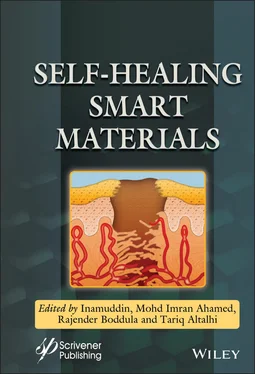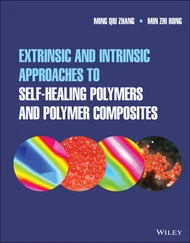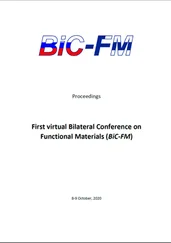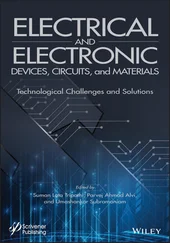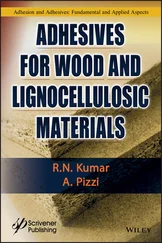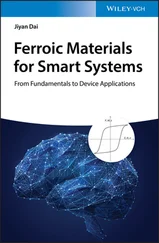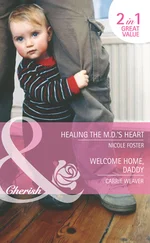Self-Healing Smart Materials
Здесь есть возможность читать онлайн «Self-Healing Smart Materials» — ознакомительный отрывок электронной книги совершенно бесплатно, а после прочтения отрывка купить полную версию. В некоторых случаях можно слушать аудио, скачать через торрент в формате fb2 и присутствует краткое содержание. Жанр: unrecognised, на английском языке. Описание произведения, (предисловие) а так же отзывы посетителей доступны на портале библиотеки ЛибКат.
- Название:Self-Healing Smart Materials
- Автор:
- Жанр:
- Год:неизвестен
- ISBN:нет данных
- Рейтинг книги:4 / 5. Голосов: 1
-
Избранное:Добавить в избранное
- Отзывы:
-
Ваша оценка:
- 80
- 1
- 2
- 3
- 4
- 5
Self-Healing Smart Materials: краткое содержание, описание и аннотация
Предлагаем к чтению аннотацию, описание, краткое содержание или предисловие (зависит от того, что написал сам автор книги «Self-Healing Smart Materials»). Если вы не нашли необходимую информацию о книге — напишите в комментариях, мы постараемся отыскать её.
Self-Healing Smart Materials — читать онлайн ознакомительный отрывок
Ниже представлен текст книги, разбитый по страницам. Система сохранения места последней прочитанной страницы, позволяет с удобством читать онлайн бесплатно книгу «Self-Healing Smart Materials», без необходимости каждый раз заново искать на чём Вы остановились. Поставьте закладку, и сможете в любой момент перейти на страницу, на которой закончили чтение.
Интервал:
Закладка:
Some researchers raised some concerns that some supramolecular rubbers may not display an adequate solvent resistance to be used as coatings, and overcame this drawback by mixing supramolecular with covalent bonds [61–65]. While the introduction of covalent bonds makes a more resistant and mechanically sound material, its backside is a decrease of the self-healing capacity, needing more time and/or higher temperatures to repair a damage in the materials.
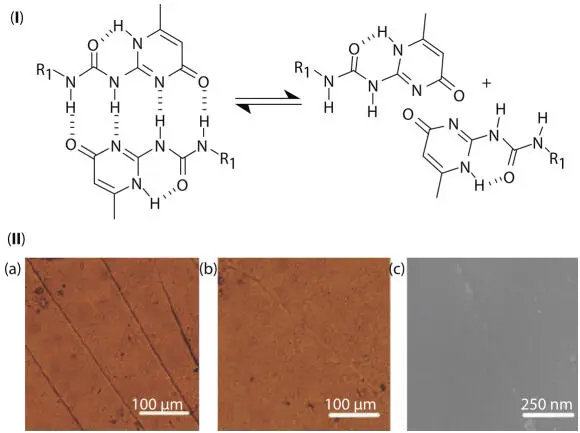
Figure 1.8(I) 2-ureido-4[1H]-pyrimidinone (UPy), and a scheme showing its association-dissociation process. (II) Self-healing of a UPy-based coating at 80 °C for 2 min: (a) and (b) optical microscope images of the coating before and after healing, and (c) SEM image of the healed coating. Reproduced with permission from Ref. [55]; Copyright (2018) John Wiley & Sons, Inc.
Networks built entirely from covalent bonds can also display self-healing ability, if some of the covalent bonds are of reversible nature. The use of reversible crosslinks based on the Diels–Alder (DA) chemistry (Figure 1.9-I) dates back to 1979 [66, 67]. Nonetheless, the use of DA crosslinks to produce self-healing crosslinked polymers was not explored until several years later [17, 68]. Chen and coworkers used multifunctional dienes and dienophiles to produce a reversible network that underwent depolymerization when heated to 120–150 °C [69]. Researchers from the same group improved some aspects of their materials by using a different maleimide to avoid the use of solvents and obtain colorless polymers, more suitable to use as coatings [70]. They identified the DA adducts as the responsible for the crack propagation, due to the relatively low amount of energy needed to break them [69, 70]. Therefore, it can be expected a very good degree of healing once the same covalent bonds are restored through a convenient thermal treatment. The temperature requirement to produce the retro-DA can be tuned by selecting the diene–dienophile pair, covering a wide temperature range from room temperature or mild heating [71, 72] to above 250 °C [73, 74]. Figure 1.9-II shows an example of DA based self-healing material. One of the weaknesses of the DA-based intrinsic self-healing thermosetting polymers is that during the healing process the material loses its crosslinked structure. An alternative to overcome this drawback is the use of the dynamic equilibrium inherent to the DA adducts. Using this approach, Zhang and colleagues demonstrated plastic deformation at low temperatures in a DA-based polymer, without complete de-polymerization, but they did not offer self-healing proofs [75].

Figure 1.9(I) Diels Alder reversible reaction. (II) (a) Synthesis of the tetrafunctional monomer (1); (b) formation of the DA-based network (3); (c)–(e) healing/recycling process. Reprinted with permission from Ref. [72]. Copyright (2014) John Wiley & Sons, Inc.
Dynamic covalent bonds (DCBs), in contrast to reversible bonds, can be used to produce self-healing intrinsic polymers that maintain their cross-linked structure even at high temperatures during the healing process [19, 76, 77]. The exchange reactions between dynamic bonds need to be activated through an external stimulus. The most usual one is heat, but some dynamic bonds respond to light, and in a lesser extent to other stimuli such as mechanical stress [78–80] or solvents [81, 82]. Light responsive DCBs based on the sulfur chemistry were extensively studied by C. Bowman’s group [83–89]. The healing mechanism of these materials relies on bond exchanges through addition-fragmentation chain transfer. These polymers are capable not only of self-healing, but also of undergoing selective plastic deformation through the use of appropriate masks. This can be used to create 2D patterns on the material, as shown in Figure 1.10-I. Matyjaszewski and co-workers also used light-activated reactions to produce self-healing polymers. Their polymeric networks have either trithiocarbonate (TTC) [90, 91] or thiuram disulfide (TDS) [92] moieties acting as the dynamic crosslinks. Mechanical tests performed on the latter showed that around 90% of the mechanical strength could be recovered by visible light irradiation (Figure 11.0-II). Some of the advantages of the use of light to trigger the self-healing are highlighted by the authors: the healing can be performed at room temperature, preserving the substrate (especially useful when it cannot withstand higher temperatures); no solvents are needed; the air atmosphere does not interfere with the healing process nor it produces any degradation by oxidation, since the temperature remains low.
Thermally activated DCBs can also be harnessed to obtain self-healing polymeric networks. Hydroxyesters, obtained from the reaction of an epoxide with a carboxylic acid and capable of undergo transesterification reactions, were first studied by Leibler and colleagues, who coined the term “vitrimers” to name these self-healing networks [21, 93, 94]. Though many different chemical groups have also been proposed as alternatives [18, 19], vitrimers based on the transesterification reaction remain the most widely studied ones. A variety of epoxy and poly-carboxylic acid precursors have been used in combination with diverse catalysts. The first systems developed by Leibler et al. consisted in a commercial epoxy resin (DGEBA) crosslinked with a mixture of di- and tri-functional fatty acids, with Zn +2to catalyze the transesterification [21, 93]. They showed that a thermal treatment at moderate temperature (100–150 °C) produces a very good welding between two pieces of the vitrimer. Other catalysts tested by the same authors include triphenylphosphine (PPh 3) and triazobicyclodecene (TBD) [94]. TBD showed an excellent catalytic activity, similar to Zn +2. TBD and Zn +2are the most frequent catalysts used for epoxy-carboxylic acid vitrimers [21, 81, 93, 95–103]. These vitrimers were used to study other relevant aspects of DCBs. For instance, Legrand and Soulié-Ziakovic studied how the dynamic bonds can be harnessed to obtain a better adhesion between the matrix and glass fibers [99]. We addressed the generation of a crosslinked polymer from difunctional precursors, at the expense of leaving a fraction of soluble smaller chains [104], which several authors have done [81, 95–97]. Other catalysts that proved to work for accelerating the transesterification reactions in vitrimers include tertiary amines [105], imidazoles [106] and Sn +2[107]. Also several uncatalyzed systems demonstrated self-healing ability, though higher temperatures or longer times are needed [108–110]. Figure 1.11 shows some examples of self-healing processes of epoxy-carboxylic acid vitrimers. Epoxy-anhydride networks with Zn +2as transesterification catalyst have also been studied as vitrimer systems though to a lesser extent [21, 93]. Epoxy-anhydride networks have higher glass transition temperatures, and higher modulus (at room temperature) when compared to epoxy-carboxylic acid ones. However, the – OH concentration, which was proved to be a critical parameter for the transesterification reactions rate [21], is much lower in the former (the epoxy-anhydride reaction yields ester groups, hence another source of hydroxyls is needed).

Figure 1.10(I) Mechanopatterning of two different samples of thiol-ene based elastomers. (a) Using a mask with concentric rings. (b) Using a mask with horizontal lines in a two step process, rotating the mask 30° between the irradiation steps. Reprinted with permission from Ref. [84]. Copyright (2011) John Wiley & Sons, Inc. (II). (a)–(c) As-prepared, cut and self-healed sample of a TDS crosslinked polymer. (d) Stress–strain curves of samples with different healing times. (e) Dependence of the elongation at break with the healing time. Reprinted with permission from Ref. [92]. Copyright (2012) John Wiley & Sons, Inc.
Читать дальшеИнтервал:
Закладка:
Похожие книги на «Self-Healing Smart Materials»
Представляем Вашему вниманию похожие книги на «Self-Healing Smart Materials» списком для выбора. Мы отобрали схожую по названию и смыслу литературу в надежде предоставить читателям больше вариантов отыскать новые, интересные, ещё непрочитанные произведения.
Обсуждение, отзывы о книге «Self-Healing Smart Materials» и просто собственные мнения читателей. Оставьте ваши комментарии, напишите, что Вы думаете о произведении, его смысле или главных героях. Укажите что конкретно понравилось, а что нет, и почему Вы так считаете.
